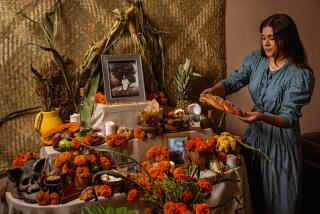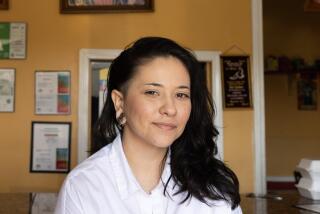Vowing to Love, Honor and Preserve Cultures
- Share via
During the recent wedding of friends Phil and Rosalva, a minor mishap drew attention to a cultural ritual that otherwise may have passed unnoticed.
At a solemn moment, shiny round objects seemed to be changing hands among the minister and the bride and groom. Then one accidentally fell to the floor of the Catholic church, echoing like a nickel on marble in a museum.
The unexpected sound jangled the curiosity of guests unfamiliar with Mexican wedding rites. Some turned to their handy glossary of customs, provided by the couple as a bicultural courtesy.
Arras: A set of 13 coins the groom gives the bride symbolizing his commitment to faithfully provide. There’s one moneda, or coin, for each month of the year, plus an extra one for good luck.
The arras accident served as a cultural icebreaker. Outside the Santa Ana church--before the newlyweds left in a shower of blown soap bubbles instead of thrown rice--Rosalva’s Latino guests explained the tradition to Phil’s non-Latino friends.
For at least a decade, inter-ethnic and interracial marriages have been on the rise in the United States, with California leading the way. I’ve personally attended or been invited to so many this year I could help keep statistics.
A Times analysis in August found that one of every six babies born statewide in 1998 had parents of mixed race or ethnicity. Such culturally blended babies are now the third largest group of newborns, after whites and Latinos.
You might assume that so much intermarriage would begin to blur cultural distinctions, that Old World ways would yield to American practicality in seeking a cultural common denominator. Simplify and homogenize.
Yet, even as we turn the heat up on the melting pot, many mixed couples are more culturally assertive, not less. In tying the knot, they also seek to tie traditions and combine communities.
“People are into expressing their own cultures and incorporating them more and more into their weddings,” said Melinda Dixon of Laguna Beach, a wedding and party consultant. “What’s really nice is that couples seem to be so much more interested in each other’s cultures.”
Phil had better be interested, warned Rosalva. Her prenuptial condition: Love me, love Mexico.
That was easy for Phil, born Pennsylvania Dutch and raised a Christian Scientist. He enjoyed learning about Latino culture while shopping with his fiance for the arras and the lazo, a silky chord that symbolically ties the bride and groom at the altar. He even helped her select her wedding dress.
What? Isn’t it bad luck for the groom to see the gown before the big day? Even Rosalva, Orange County bred, balked at the risk. But her mother reassured her: “Don’t worry. That’s an Anglo custom.”
So Phil, free of one superstition, picked up his bride in a borrowed Rolls-Royce and they rode together to church, having already vowed to raise bilingual and bicultural children.
Cultural adaptation got a little more complicated when Hector married Amy earlier this month. He was born and raised in Boyle Heights by Mexican immigrants. She’s a recent college grad, daughter of Chinese parents who fled Vietnam when she was a girl.
Nothing Mexican about their wedding; it was Chinese all the way. From the roast pig delivered by the groom as a gift to the formal tea ceremony, served by the respectfully bowing couple.
Hector, who suffered a nervous nosebleed, found the 12-hour affair a bit overwhelming. His aunts who came from Mexico were bewildered by some of the antics their normally inhibited nephew had to endure for love. As a bargaining game at the bride’s threshold, the groom was asked to sing with a rose in his mouth, dance, and say “I love you” in four languages. Later, he and his new wife played risque games during a big banquet featuring jellyfish and shark-fin soup, but no tortillas.
Back from the honeymoon, Hector now regrets ignoring his side of the cultural equation. He’s laid back when it comes to customs, unsure of his own traditions. Maybe he should have just insisted on a dollar dance as a Latino touch.
“It brought into sharp focus that I’m pretty Americanized,” Hector admitted Monday. “Even if I were to assert my own customs, I’d be flailing. I’d have to hire a consultant.”
Afterward, he found himself reaffirming his agreement with Amy to baptize their children Catholic, though he hasn’t been to church in years.
“In terms of my culture, I’m very lazy,” Hector said. “I don’t think enough about it, unless it’s brought to the fore by something--like a Chinese wedding.”
*
Agustin Gurza’s column appears Tuesday. Readers can reach Gurza at (714) 966-7712 or [email protected]
More to Read
Sign up for Essential California
The most important California stories and recommendations in your inbox every morning.
You may occasionally receive promotional content from the Los Angeles Times.










